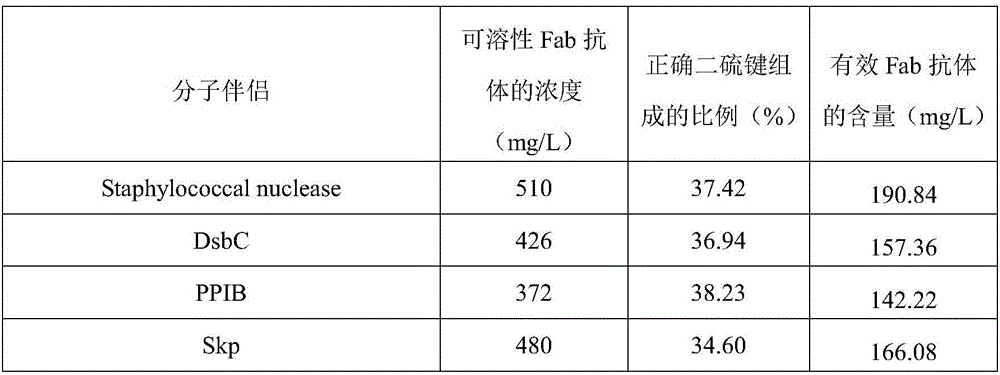Recombinant engineered Escherichia coli for expressing anti-TNF antibody Fab fragment
A technology for recombinant Escherichia coli, Escherichia coli, applied in bacteria, microorganism-based methods, enzymes, etc., can solve problems such as mispairing of disulfide bonds, misfolding, etc.
- Summary
- Abstract
- Description
- Claims
- Application Information
AI Technical Summary
Problems solved by technology
Method used
Image
Examples
Embodiment 1
[0037] Example 1: Construction of recombinant Escherichia coli engineering bacteria that co-express hPDI and the heavy chain amino acid sequence of SEQ ID No:7, the Fab fragment of the light chain amino acid sequence of SEQ ID No:8
[0038] The secretion and expression of Fab antibody in the periplasmic space of Escherichia coli is achieved by introducing the target gene into the empty plasmid expression vector, constructing the recombinant plasmid expression vector, and then transferring it into the Escherichia coli engineering bacteria to construct the recombinant Escherichia coli engineering bacteria.
[0039] 1) Construction and amplification of the target gene
[0040] Before the heavy chain gene sequence of the Fab antibody (the corresponding amino acid sequence is shown in SEQ ID No: 7), a section of OmpA signal peptide gene sequence (the corresponding amino acid sequence is shown in SEQ ID No: 9) is introduced, and then a section containing ribose is inserted The conne...
Embodiment 2
[0073] Example 2: Construction of recombinant Escherichia coli engineering bacteria that co-express hPDI and the heavy chain amino acid sequence of SEQ ID No:1, the Fab fragment of the light chain amino acid sequence of SEQ ID No:2
[0074] Method basically with reference to embodiment 1, but difference is as follows:
[0075]1) When constructing and expressing the target gene of the Fab antibody, the heavy chain gene sequence of the Fab antibody is the nucleotide sequence corresponding to the amino acid sequence of SEQ ID No: 1, and the light chain gene sequence of the Fab antibody is corresponding to the amino acid sequence of SEQ ID No: 2 the nucleotide sequence.
[0076] 2) The empty plasmid vector is pET23b, and the recombinant plasmid expression vector thus prepared is named HL-pET23b.
[0077] 3) HL-pET23b was transformed into hPDI-pCDFduet / BL21(DE3) competent cells to obtain recombinant Escherichia coli engineering strain HL-pET23b / hPDI-pCDFduet / BL21(DE3).
Embodiment 3
[0078] Embodiment 3: the construction of the recombinant Escherichia coli engineering bacterium of the Fab fragment of the heavy chain amino acid sequence of coexpressing hPDI and SEQ ID No:3, the light chain amino acid sequence of SEQ ID No:4
[0079] Method basically with reference to embodiment 1, but difference is as follows:
[0080] 1) When constructing and expressing the target gene of the Fab antibody, the heavy chain gene sequence of the Fab antibody is the nucleotide sequence corresponding to the amino acid sequence of SEQ ID No: 3, and the light chain gene sequence of the Fab antibody is corresponding to the amino acid sequence of SEQ ID No: 4 the nucleotide sequence.
[0081] 2) The empty plasmid vector is pET24a, and the recombinant plasmid expression vector thus prepared is named HL-pET24a.
[0082] 3) HL-pET24a was transformed into hPDI-pCDFduet / BL21(DE3) competent cells to obtain recombinant Escherichia coli engineering strain HL-pET24a / hPDI-pCDFduet / BL21(DE3)...
PUM
 Login to View More
Login to View More Abstract
Description
Claims
Application Information
 Login to View More
Login to View More - R&D Engineer
- R&D Manager
- IP Professional
- Industry Leading Data Capabilities
- Powerful AI technology
- Patent DNA Extraction
Browse by: Latest US Patents, China's latest patents, Technical Efficacy Thesaurus, Application Domain, Technology Topic, Popular Technical Reports.
© 2024 PatSnap. All rights reserved.Legal|Privacy policy|Modern Slavery Act Transparency Statement|Sitemap|About US| Contact US: help@patsnap.com










